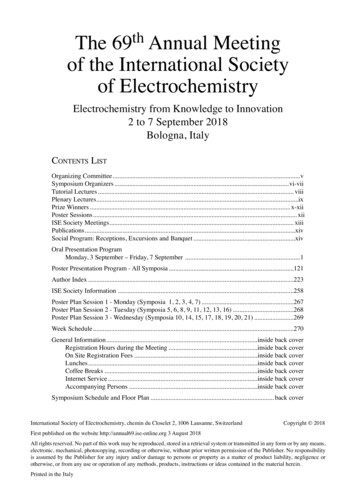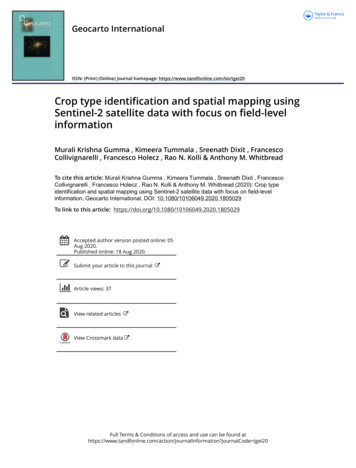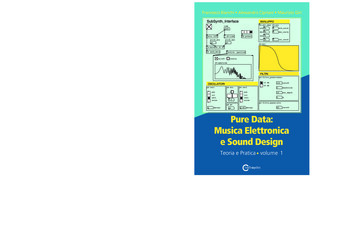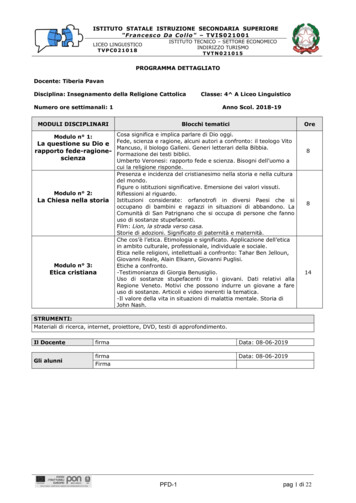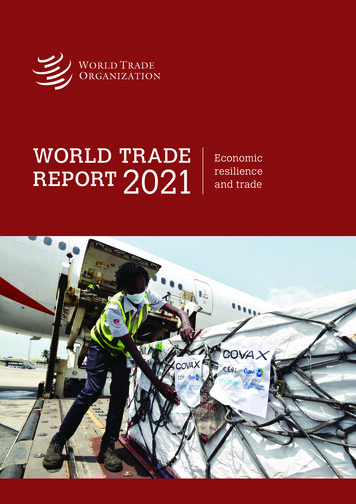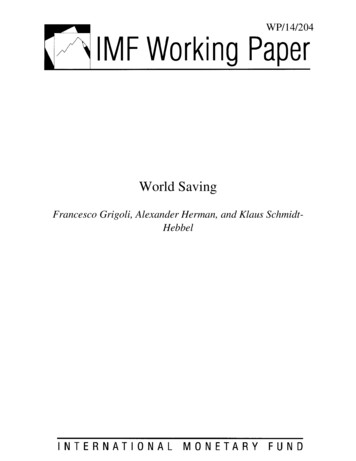
Transcription
WP/14/204World SavingFrancesco Grigoli, Alexander Herman, and Klaus SchmidtHebbel
WP/14/204 2014 International Monetary FundIMF Working PaperWestern Hemisphere DepartmentWorld Saving1Prepared by Francesco Grigoli, Alexander Herman, and Klaus Schmidt-Hebbel2Authorized for distribution by Przemek GajdeczkaNovember 2014This Working Paper should not be reported as representing the views of the IMF.The views expressed in this Working Paper are those of the author(s) and do not necessarilyrepresent those of the IMF or IMF policy. Working Papers describe research in progress by theauthor(s) and are published to elicit comments and to further debate.AbstractThis paper presents new evidence on the behavior of saving in the world, by extendingprevious empirical research in five dimensions. First, it is based on a very large and recentdatabase, covering 165 countries from 1981 to 2012. Second, it conducts a robustnessanalysis across different estimation techniques. Third, the empirical search is expanded byincluding potential saving determinants identified by theory but not previously considered inthe empirical literature. Fourth, the paper explores differences in saving behavior nesting the2008-10 crisis period and four different country groups. Finally, it also searches forcommonalities and differences in behavior across national, private, household, and corporatesaving rates. The results confirm in part existing research, shed light on some ambiguous orcontradictory findings, and highlight the role of neglected determinants. Compared to theliterature, we find a larger number of significant determinants of saving rates, using differentestimators, for different periods and country groups, and for different saving aggregates.JEL Classification Numbers: C23, E21, H30Keywords: consumption, corporate saving, Global Financial Crisis, household saving, nationalsaving, private savingAuthors’ E-Mail Addresses: fgrigoli@imf.org; aherman@imf.org; kschmidt-hebbel@uc.cl.1We thank Przemek Gajdeczka, Michele Imbruno, Melissa Jimenez, Alvar Kangur, Norman Loayza, HumbertoLópez, Nicolas E. Magud, Luca Ricci, Belen Sbrancia, Luis Servén, Gonzalo Varela, and Alejandro Werner fortheir comments and suggestions. In particular, we thank Jesus Gonzalez-Garcia for his valuable contribution duringthe early stage of this work.2Instituto de Economía, Pontificia Universidad Católica de Chile.
2ContentsPageAbstract .1I. Introduction .3II. Private Saving Determinants .4III. Data and Stylized Facts .13A. Sources and Construction.13B. Stylized Facts .13IV. Empirical Strategy .19V. Results .22A. Baseline Specification .22B. Alternative Specifications .26C. Time Periods and Country Groups .29D. National Saving .32E. Household and Corporate Saving .33VI. Conclusions.37Appendix I. Data .39A. Concept Construction and Variable Generation .39B. Data Replacement, Splicing, and Augmentation .43C. Dataset Cleaning .45Appendix II. Country Groups .47Appendix III. Contributions .48Tables1. Determinants of Private Saving in Previous Studies .82. Descriptive Statistics .143. Correlation Matrix of Core Private Saving Determinants .144. Determinants of Private Saving, Different Estimators .235. Determinants of Private Saving, Additional Explanatory Variables .266. Determinants of Private Saving, Interactions .307. Determinants of National Saving, Alternative Estimators .338. Determinants of Household and Corporate Saving, Baseline Specification.359. Determinants of Household and Corporate Saving, Additional Explanatory Variables .36A1. List of Countries.47Figures1. World Saving Rates, 1981-2012 .162. World Private Saving Rates, 1981-2012 .173. Pairwise Panel Correlations .18A1. Average Contributions of the Fitted Values .49References .50
3I. INTRODUCTIONWhat does consumption theory say about the main determinants of private saving decisionsand which are the empirical measures that should be used to test for their relevance inexplaining aggregate consumption/saving patterns? What determines the behavior ofnational, private, household, and corporate saving rates in the world? Did the exceptionaldepth of the Global Financial Crisis change the behavioral relationships of private saving andits determinants? And do saving determinants change across different country groups?There is a small body of empirical saving studies using macroeconomic panel datasets thataddress some of these questions. A review of 15 empirical studies of mostly private savingrates reveals large differences in their sample size and coverage, data sources, saving ratedefinitions, model specifications, and estimation methodologies. Unsurprisingly, they alsoshow large differences in empirical results that are difficult to reconcile.This paper addresses limitations and contradictory findings of previous empirical research,extending it in five dimensions. First, it is based on a very large and more recent paneldatabase for world saving, covering 165 countries from 1981 to 2012. This is almost fourtimes the size of the most comprehensive panel study published to date by Loayza et al.(2000). Second, it conducts a robustness analysis across different estimation techniques.Third, the empirical search is expanded by including potential saving determinants identifiedby theory but not previously considered in the empirical literature. Fourth, the paper exploresdifferences in saving behavior across time and space, nesting the 2008-10 crisis period andfour different country groups. Finally, while this paper’s focus is on private saving, it alsosearches for commonalities and differences in behavior across national, private, household,and corporate saving rates.Our results confirm some of the findings of the literature and unveil some novel features.Private saving rates are generally persistent and positively associated with income levels andincome growth. Terms-of-trade improvements also contribute to a rise in saving through theireffect on income. Permanent components of income and the terms of trade increase saving,and temporary parts of the terms of trade are saved to a larger extent than permanent parts.Saving is spurred by inflation, possibly due to precautionary motives. Increased creditavailability, which is often associated with a process of financial liberalization, depressesprivate saving. A higher old-age dependency ratio reduces saving as the elderly finance theirconsumption needs with accumulated savings. Urbanization lowers private saving rates.Higher public saving reduces private saving, but exhibiting only partial Ricardian offsetting.Higher expected future growth has a positive effect on private saving, as does access toforeign borrowing. Finally, a higher share of young dependents reduces saving.We also find that results differ across time periods and country groups. During the GlobalFinancial Crisis, private saving inertia, income levels, and urbanization had diminished
4effects on saving. Compared to private saving in other country groups, saving in advancedeconomies is more responsive to income growth and almost non-sensitive to demographicvariables, while low-income developing countries show a lower response of private saving toincome growth and less persistent private saving rates. Private saving in oil exporters ispositively associated with a larger old-age population share. High-growth Asian economies’private saving rates are relatively more sensitive to real deposit rates.We then replicate our empirical search for the national saving rate, with results that arelargely in line with those reported for private saving. Finally, we check robustness of ourresults for private saving by estimating regressions separately on household and corporatesaving. We also confirm many of the empirical findings reported for private saving at thehousehold and corporate levels.The paper structure is the following. In the next section we first review the determinants ofprivate saving by briefly discussing the main consumption theories that drive the selection ofempirical saving determinants. Then, we provide an overview of panel data studies on thebehavior of private saving rates. Section III summarizes our data sources and constructionand presents descriptive statistics, stylized facts on saving patters, and pairwise correlationswith key potential determinants. Section IV outlines our empirical strategy, describing ourchoice of regression models. The empirical results are reported in Section V. Section VIconcludes.II. PRIVATE SAVING DETERMINANTSWe review the determinants of private saving in two steps, extending previous surveys bySchmidt-Hebbel and Servén (1997) and Loayza et al. (2000). First, we briefly discuss themain theories of consumption and saving that drive the selection of potential regressors inempirical studies on aggregate consumption and saving. Then, we provide a compactoverview of the empirical panel data literature on the behavior of aggregate private savingrates.The starting point of modern theoretical research on consumption and saving is defined bytwo dominant models: the permanent-income hypothesis (PIH) and the life-cycle hypothesis(LCH). In contrast to the preceding Keynesian hypothesis (KH), in which consumption isdetermined by current income, the PIH focuses on a representative, infinitely-lived consumerwho equates consumption to permanent income net of the present value of taxes (Friedman,1957; Hall, 1978). As a variant of the PIH, the Ricardian-equivalence hypothesis (REH)derives permanent income as net of the present value of government spending, by makinguse of the representative consumer’s and the government’s budget constraints, which arelinked by tax payments (Barro, 1974). If a large number of stringent (and empiricallyimplausible) conditions are satisfied (Seater, 1993), the REH predicts that an increase inpermanent government consumption is fully offset by lower private consumption.
5The PIH assumption of homogeneous consumers contradicts observed consumerheterogeneity along several dimensions, including age, income, and access to borrowing.This leads to the main competitor of the PIH, the LCH, which introduces age-relatedconsumer heterogeneity (Modigliani and Brumberg, 1954; Attanasio and Weber, 2010).Here, aggregate saving reflects the addition of saving by different age specific, finitely-livedcohorts who save for their old-age while working, dissave during retirement, and do not leavebequests. However, these LCH predictions are also at odds with the evidence. Plannedbequests are empirically large and sensitive to income levels, implying elasticities ofconsumption to permanent income that are significantly lower than one.Contradicting the PIH and LCH, consumption tends to exhibit excess sensitivity, i.e., itschange is correlated with predictable changes in other variables.3 This is partly explained bythe presence of durable goods (Caballero, 1991), consumption habits (external habits—Abel,1990—or internal habits—Ferson and Constantinides, 1991), or consumer time inconsistencyreflected in hyperbolic discounting (Laibson, 1997).4Uncertainty can also explain in part the failures of the deterministic versions of the PIH-REHand LCH. Classical uncertainty or risk about future realizations of stochastic variables (butnot about distributions of stochastic variables, which are assumed to be known andstationary) leads to precautionary saving by risk-averse consumers (Skinner, 1988; Zeldes,1989). When risk-averse consumers face additional Knightian uncertainty (i.e., distributionsof stochastic variables are unknown), precautionary saving is raised further (Miao, 2004;Hansen and Sargent, 2010).Other theories substantially modify several key assumptions of the PIH-REH and LCH toderive behavioral predictions that are more consistent with the data. Borrowing constraints—the fact that interest rates on loans cannot be expected to rise to clear financial marketsbecause they raise default risks (Stiglitz and Weiss, 1981) or because human capital cannotbe used as collateral (Hayashi, 1982)—push consumers toward corner solutions and makeborrowers’ consumption levels more sensitive to credit volumes and current income than tointerest rates and wealth. When precautionary saving and borrowing constraints arecombined, forward-looking, risk-averse consumers incur in buffer-stock saving, anticipatingtighter future borrowing constraints (Schechtman, 1976).3Related to excess consumption sensitivity is the empirical rejection of stochastic versions of the consumptionEuler equation (Hansen and Singleton, 1982) and evidence of excessive equity return premiums over fixedincome asset returns (Mehra and Prescott, 1985).4Hyperbolic discount functions present a high discount rate over short horizons and a low discount rate overlong horizons. This discount structure induces dynamically inconsistent preferences, implying a motive forconsumers to constrain their future choices.
6According to the “capitalist spirit” model, which traces back to Smith and Marx, bothconsumption and wealth are valued by consumers (Cole et al., 1992; Fershtman and Weiss,1993). If consumption and wealth are gross substitutes in utility, higher wealth does not raiseconsumption; instead, it is largely saved, contradicting the PIH-REH and the LCH.Another dimension of consumer heterogeneity reflects differences in income and wealthacross different population groups. The incidence of absolute poverty affects aggregateconsumption because the poor save little. Then, utility is a positive function of the differencebetween current consumption and a subsistence consumption level (Christiano, 1989).5Therefore, the saving rate declines with absolute poverty (given income distribution) andrises with the level of income—a refined version of autonomous consumption in aconventional KH model.Post-Keynesian models stress the positive effect of functional income inequality onaggregate saving based on the observation that workers save less than capitalists (Lewis,1954; Kaldor, 1957). More recent models focus on various channels from personal incomeinequality to saving, which, taken together, suggest that the effect of income distribution onsaving is ambiguous.6We end this brief survey of consumption theories by referring to the integration of householdand corporate saving behavior. If a set of strict (and empirically implausible) assumptions aremet, household owners of corporations are indifferent between saving as households orthrough their corporations. They are then able to “pierce the corporate veil,” offsetting oneto-one higher corporate saving by lower household saving. This hypothesis is the householdcorporate saving analogue to the REH for government-private saving decisions.Table 1 summarizes categories of saving determinants, specific variables in each category,expected signs of their saving effects according to consumption theories, and the empiricalcounterparts in country-panel studies based on aggregate saving data. It is important to notethat each potential saving determinant is listed only once in Table 1, under the variable5Variants of this theory specify the intertemporal elasticity of substitution as an increasing function of wealth(Atkeson and Ogaki, 1993) or of the distance between permanent income and subsistence consumption (Ogakiet al., 1995). An implication of the two latter hypotheses is that the sensitivity of consumption substitutiongrows with the level of income.6On the one hand, according to LCH with bequests, wealthier individuals should have higher saving rates asbequests are a luxury (Kotlikoff and Summers, 1981 and 1988). Thus a larger share of poorer individuals candepress private saving. Similarly, the inability to borrow generally affects the poorest and this is likely tonegatively affect saving (Deaton, 1991). On the other hand, income inequality may positively affect privatesaving through the precautionary motive (Carroll and Kimball, 1996). Moreover, if the poor face more limitedaccess to risk diversification options or are more risk averse (especially in light of higher uncertainty), theywould increase saving.
7category to which it is most closely related by theory. However, both the expected sign andthe signs reported in the empirical literature reflect the combined effects on saving predictedby different theoretical hypotheses. In fact, the latter relations could have opposite signs. Forexample, higher wealth leads to higher consumption according to the PIH but lowersconsumption if wealth and consumption are substitutes in utility; hence, the expected effectof wealth on saving is ambiguous.We now present the variable categories and discuss expected signs of the specific variableson private saving. When discussing the expected signs of the saving determinants one by one,we hold constant the influence of other variables. For example, when analyzing the effects ofinflation, we take the level of current income as given.Income. PIH and LCH predict that current income should be largely saved. Consumptionhabits reinforce the saving effect predicted by PIH for higher current income. However,when fundamental assumptions of the PIH and the LCH are not satisfied or whenconsumption habits are weak, current income may raise consumption (in the extreme, one toone) when (i) it accrues to borrowing-constrained consumers, (ii) it signals higher futureincome, or (iii) it accrues to poor consumers that consume close to their subsistence incomelevel. In these cases, marginal consumption of current income is high and marginal saving islow.7Income reflects (unobserved) temporary and permanent income components. This distinctionmakes the prediction of the PIH and the LCH sharper (as long as the separation of currentincome into estimates for temporary and permanent components is statistically wellgrounded), being that permanent income should be consumed while temporary incomeshould be saved. Again, however, deviations from the latter prediction are observed when theassumptions of the PIH are not satisfied, as in the three cases described above.Higher income growth could lead to an upward estimation of wealth, which reduces savingunder the PIH. Under the LCH, the general effect of growth is ambiguous. Under the wealthin-utility theory, higher wealth leads to less consumption and more saving. Therefore, growthhas an ambiguous effect on saving.7When the rate of saving to income is specified as a function of income, this is consistent with a consumptionfunction where the level of consumption is a linear function of the level of income and the product of incomeand the function of income. While empirically unlikely, the coefficient of the latter product (which is equal tothe negative of the coefficient of the function of income in the saving ratio specification) could be positive.
8Table 1. Determinants of Private Saving in Previous StudiesVariable CategoryIncomeWealthRates of return on financial assetsRelative pricesClassical uncertainty (risk)Knightian uncertaintyDomestic borrowing constraintsForeign borrowing constraintsFinancial depthDemographicsPoverty and distributionFiscal policyGovernment spending componentsPension SystemHouseholds and firmsSpecific VariableIncome level: currentIncome level: estimated temporary / permanentGap of current to estimated potential incomeIncome growth: currentIncome growth: expected futureTotal wealthNet assetsNet foreign assetsReal interest rateReal return on variable-income assetsConsumer price index (CPI): current levelCPI inflation: currentCPI inflation: expected futureTerms of trade: currentTerms of trade: estimated temporary / permanentReal exchange rate: levelReal exchange rate: expected future changeFinancial risk, financial instability, financial crisisMacroeconomic instability, macroeconomic crisisPolitical instability or political riskViolent conflict, warVariance of innovations to saving determinantsMeasures of Knightian uncertaintyCurrent credit flows, current money flowsForeign lendingCurrent account deficitForeign savingSovereign debt premiumCapital flow restrictionsBank credit stockFinancial assetsBroad money stockOld-age dependencyYoung-age dependencyUrbanizationPovertyIncome concentrationWealth concentrationCapital income sharePublic sector savingPublic sector budget balancePublic consumptionEducation and healthPensionsIn-kind transfersPay-as-you-go pension transfers to oldMandatory fully-funded pension systemcontributionsFully-funded pension assetsCorporate saving effect on household savingExpected SignAmbiguous( ) / 0 or ( )( guousAmbiguous( )( )Ambiguous0 or ( )( ) / 0 or ( )AmbiguousAmbiguous( ) AmbiguousAmbiguousAmbiguousAmbiguous( )( ) or ambiguous(-)(-)(-)(-)( )( guousAmbiguous( )(-)0 or (-)AmbiguousAmbiguousAmbiguousAmbiguousAmbiguous0 or ( )Empirical Findings0 (5, 6, 13), (1, 2, 3, 4, 7, 15), 0 or (9)0 (7) / 0 (7)Ambiguous0 or (-)0 or (5)- (15) (7, 9, 10, 11, 12, 13, 14), 0 (15) (14)- (7, 10), 0 (1, 3, 5, 6, 11), (2, 12, 14), 0 or (15)- (4), 0 (1, 2, 3, 6, 10, 15), (7, 12, 13)0 (13, 15), (2, 4, 6, 7, 10, 11) (7) / (7)- (7, 11, 12), (3), or - (14)- (1, 2, 3, 7)- (13)0 (7)-(5), 0 (7)0 (7, 15), (1, 3, 4, 13)- (2, 3, 4, 7, 10, 11, 14, 15), 0 (5, 6, 13, 15), (12)- (7, 14, 15), 0 (9)- (3, 7, 15)- (13), 0 (3, 9)- (1, 3, 7, 10, 15)- (2, 5, 6, 8, 11, 13), 0 (4), or - (12)- (2, 6) 0 (8)- (3, 4, 5) (4)Notes: The qualitative results listed in the last column of this table summarize signs of saving regressors reported in 16 panel studies of private saving. Positiveand negative signs correspond to statistically significant coefficient estimates, while 0 denotes coefficient estimates that are not significantly different from zero.The sources are the corresponding tables and specific columns, rows, or regressions of the following studies: 1. Corbo and Schmidt-Hebbel (1991) (table 4); 2.Masson, Bayoumi, and Samiei (1995) (table 2, “restricted model” column); 3. Edwards (1996) (table 2, column 5); 4. Dayal-Ghulati and Thimann (1997) (table 4,column 2); 5. Bailliu and Reisen (1998) (table 1, columns 3 and 4); 6. Haque, Pesaran, and Sharma (1999) (table 6, columns 4 and 5); 7. Loayza, SchmidtHebbel, and Servén (2000) (table 4, column 6; table 7); 8. López, Schmidt-Hebbel, and Servén (2000) (tables 4 to 6); 9. Schmidt-Hebbel and Servén (2000) (table6, columns 7 and 8); 10. De Serres and Pelgrin (2003) (table 2); 11. IMF (2005) (table 2.2, column 1); 12. Hondroyiannis (2006) (table 5, last row); 13. Gutiérrez(2007) (table 5, regression 9); 14. Horioka and Terada-Hagiwara (2012) (table 1, models 7 to 9); and 15. Bebczuk and Cavallo (table 3.1, columns 2 and 4).Significant coefficient signs are identified by a plus or a minus. Results identified by a zero mean either an insignificant coefficient in the corresponding columnof the original study or, when the variable is omitted from the particular specification reported in the column, a significant or insignificant variable in a differentcolumn of the same table. When denoted by two signs separated by "or", it denotes that the coresponding signs are reported in different columns. Real rates ofreturn are measured either on deposits or loans. Each study is identified in the table by the corresponding number in parentheses.Wealth. Consumer wealth comprises net financial assets, real assets (housing, consumerdurables), and human wealth (the discounted present value of expected future labor income).If REH holds and if households pierce the corporate veil, consumer wealth isindistinguishable from national wealth after full consolidation of household, corporate, andgovernment assets and liabilities. As discussed above, the saving effect of wealth and itscomponents is ambiguous.
9Rates of return on financial assets. According to the PIH and the LCH, a rise in the rate ofreturn on financial assets held by consumers entails income, substitution, and human-wealtheffects. If the consumer is a net creditor (a net holder of financial assets), the substitution andhuman-wealth effects of a higher rate of return on saving are positive, while the incomeeffect is negative, hence the combined net effect is ambiguous. If the consumer is a netdebtor, the income effect turns positive. Thus, higher bank deposit rates are likely to have anambiguous effect on saving while higher lending rates are likely to reduce lending and raisesaving. The overall effect of higher interest rates on aggregate private saving is ambiguous.Relative prices. Relative prices of consumption and major consumption components affectsaving because they entail intertemporal and intratemporal substitution effects, as well asincome effects. Higher current consumer price inflation raises current prices of consumergoods relative to past prices, leading to higher saving. At the same time, current inflationsignals macroeconomic instability, raising precautionary saving. Also, higher expected futureinflation lowers the ex-ante real interest rate, inducing intertemporal substitution, income,and human-wealth effects that, on balance, imply an overall ambiguous (positive) effect onsaving by savers with positive (negative) net financial asset positions.Improved terms of trade entail a direct increase in net income from abroad, benefitingconsumers by a proportional positive effect on income. Regarding the composition ofconsumption, imported goods typically represent a much larger share of consumption thanexportable goods. Therefore, higher terms of trade are likely to reduce the averageconsumption deflator. In sum, higher current terms of trade are likely to affect savingpositively. Like in the case of income, when distinguishing between estimated temporary andpermanent components of the terms of trade, the former is expected to be largely saved andthe latter to be consumed.For consumption decisions, the real exchange rate is a relative price between differentcategories of consumption spending: domestic to imported goods or non-traded to tradedgoods. A change in the current relative price level of different consumption categories has anambiguous effect on the consumption deflator (depending on the consumption basket) andtherefore on saving. Similarly, an expected future appreciation of the real exchange rate hasan ambiguous effect on saving.8Risk and uncertainty. The precautionary saving theory predicts that higher levels ofclassical and Knightian uncertainty lead to higher precautionary saving. Therefore, higher8A real exchange rate appreciation entails intertemporal substitution, income and, human-wealth effects, inaddition to an intratemporal consumption effect (Dornbusch, 1982). The first three effects are similar to those ofan interest rate reduction because they affect the consumption-based real rate of interest. Hence, like in the caseof the real interest rate, an expected real exchange rate appreciation has an ambiguous effect on saving. pag
4 effects on saving. Compared to private saving in other country groups, saving in advanced economies is more responsive to income growth and almost non-sensitive to demographic
